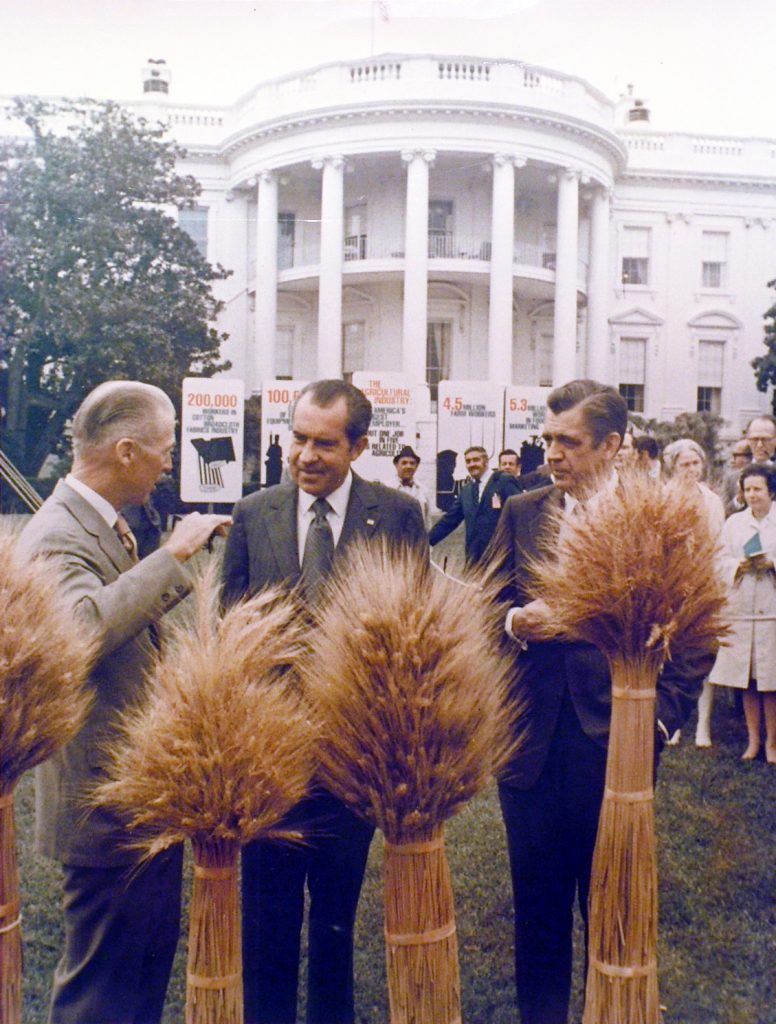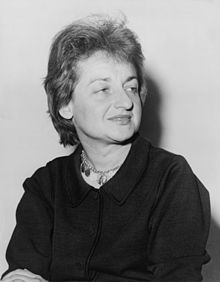We have all heard of the term of selective breeding, which consists of picking two specimens with traits you find useful and breeding them to produce offspring with the desired trait. This is a practice that has been used since antiquity—ranging from breeding the more docile wolves of the pack which eventually led to modern age dogs, to the Dutch simply selectively breeding carrots in order to make them reach a bright orange color.1 While this practice has always been used, it wasn’t until the 20th century that it reached a world status by giving humanity a more reliable source of food, and consequently saving over 200 million lives.2
Norman Borlaug was an American plant pathologist who obtained his bachelors, master’s and doctorate degrees from the University of Minnesota in 1937, 1939, and 1942 respectively. In 1944, Norman was appointed by the Mexican government and the Rockefeller Foundation to lead a research project focused in scientific research in genetics involving plant breeding with a purpose of improving yield in crops. He was stationed in northern Mexico and immediately began experimenting with selective breeding there.3
The 1940s were a rough stage in human history; while the population was growing at an accelerated rate in undeveloped countries such as India, Pakistan, and Mexico, crop yields were growing at a much slower rate in the same countries. International aid consisted of “first world” countries sending surplus food to “third world” or “developing” nations. This proved effective for some time, but the nations sending out the aid quickly realized that they were only temporarily fixing the problem.4 A solution for this critical problem would eventually be provided by the research Norman and his fellows did in Mexico, following the development of a dwarf plant.
When Norman arrived in Mexico in 1944, he arrived in a country where not enough wheat being was produced to feed the general population, inciting concern on how the country would feed its people in the future.2 Mexico relied on importing the remainder of the wheat needed to feed its people, and it yearned to rise to self-sufferance. Norman worked with already existing varieties of crops, selectively breeding them to be more resistant to weather and plagues. Norman himself claimed that “It is the unusual breadth of adaptation, combined with high genetic yield potential, short straw, a strong responsiveness and high efficiency in the use of heavy doses of fertilizers, and a broad spectrum of disease resistance that had made the Mexican dwarf varieties the powerful catalyst that they have become in launching the Green Revolution.”5

The effect that this High Yielding Crop had in Mexico’s food production was immense. In the span of six years, Mexico’s wheat production tripled, accomplishing something quite impressive in such a short amount of time. This drew the attention of other developing countries, namely India and Pakistan, who requested help in getting their crop yield to rise by utilizing Norman’s High Yielding Crop as they were also struggling to feed their people.6
Agriculture in India at the time was known for being very primitive and based on low yields. The only reason they had managed to support the population growth was due to the large amounts of land dedicated to agriculture.7 In India, about 70% of the population was involved in some form of agriculture, while the United States boasted only 5% of its workforce in the same economic sector. This alone should provide an example of just how efficient agriculture was in the US compared to developing nations.8
The hybrid crops were introduced to India and Pakistan in 1967, and they were generally accepted by the populace at large. In a matter of years, its utilization started giving positive results. India and Pakistan would become self-sufficient in wheat and cereal production by 1974, proving once again the advantage of the high yielding crops.9
The success in India and Mexico drew the attention of the Nobel prize awarding committee, who, after a careful review, decided to give Norman the prize in 1970. Norman’s high yielding crops had lowered child mortality and raised life expectancy throughout the world, saving millions of lives. Each Nobel Laureate receives a monetary prize to ensure their economic stability throughout their lives, but Norman only used the money he received from the Nobel prize to establish a food world prize, one to honor contributions in improving the world’s food supply.10

Soon after India, many other countries started using Norman’s techniques to try to become self-sufficient in food production. Norman trained a group of scientists that would eventually spread the “green revolution” to the Middle East, Northern Africa, and South America.11 While the High Yielding Crops were very successful around the world, the progress in Africa was wholly stagnant. This phenomenon was due in part to Africa’s low level of development compared to the other nations where the crops were implemented. Transportation methods in Africa were not as developed as they were in India, and the crops and fertilizers could not easily reach every farmer.12

Norman knew this could be a problem, and, in 1986, started working towards improving African agricultural development.13 Norman’s hard work, coupled with funding from Jimmy Carter and Roichi Sasakaw, a Japanese industrialist, resulted in the doubling of yields in many African countries.14
The fight against mass starvation hadn’t been won yet. Norman’s crops, while being helpful, also had a huge weakness: the interbreeding of all the wheat specimens to produce the high yielding variety had resulted in lower diversity of wheat as a species. This meant that a single plague could result in the catastrophic event of the high yielding variety becoming extinct. Because Norman’s plants were being used worldwide, a virus could leave humanity with little to no food supplies. Norman’s crops were also heavily dependent on fertilizer, which resulted in constant damage to the surrounding environments. Without fertilizer, the crops would be even less efficient than the regular non-high yield variety.15
Norman worked the remainder of his life to improve crop yields and raise awareness about world hunger. His work fell victim to many critics, and they often claimed that he favored monoculture, which describes the idea of mass planting and harvesting of a single crop, which produces a detrimental impact on the environment, turning agriculture a corporate business.16
Regardless of the critics, Norman is nevertheless credited for saving millions of lives and improving the quality of life in most undeveloped countries. He left a legacy of service and became an icon for the scientific community. Several companies have continued his work by researching higher yield crops to prevent malnutrition. Norman died with a sense of accomplishment in 2009 at age 95 in Dallas, Texas.17

When wheat is ripening properly, when the wind is blowing across the field, you can hear the beards of the wheat rubbing together. They sound like the pine needles in a forest. It is a sweet, whispering music that once you hear, you never forget.
-Norman Borlaug18
- Broomhall, Susan, and Winthrop, “Explainer: Why Are Carrots Orange?” The Conversation, March 30, 2019. http://theconversation.com/explainer-why-are-carrots-orange-20646. ↵
- Norman E. Borlaug, “The Green Revolution: For Bread and Peace.” Bulletin of the Atomic Scientists 27, no. 6 (June 1, 1971): 6–8, https://doi.org/10.1080/00963402.1971.11455372. ↵
- https://www.nobelprize.org/prizes/peace/1970/borlaug/biographical/. ↵
- U.S. Department of State, “A Short History of U.S. International Food Assistance,” USA Pavilion, https://2009-2017.state.gov/p/eur/ci/it/milanexpo2015/c67068.htm. ↵
- Norman E. Borlaug, “The Green Revolution: For Bread and Peace.” Bulletin of the Atomic Scientists 27, no. 6 (June 1, 1971): 6–8, https://doi.org/10.1080/00963402.1971.11455372. ↵
- Salem Press Encyclopedia, 2016, s.v. “Green Revolution,” by Maya Muir. ↵
- A. K. Chakravarti, “Green Revolution in India,” Annals of the Association of American Geographers 63, no. 3 (September 1973): 319–30. https://doi.org/10.1111/j.1467-8306.1973.tb00929.x. ↵
- Norman E. Borlaug, “The Green Revolution: For Bread and Peace.” Bulletin of the Atomic Scientists 27, no. 6 (June 1, 1971): 6–48. https://doi.org/10.1080/00963402.1971.11455372. ↵
- “Norman E. Borlaug, Ph.D.” Academy of Achievement, April 6, 2018, https://www.achievement.org/achiever/norman-e-borlaug/#biography. ↵
- “Norman E. Borlaug, Ph.D.” Academy of Achievement, April 6, 2018, https://www.achievement.org/achiever/norman-e-borlaug/#biography. ↵
- “Norman E. Borlaug, Ph.D.” Academy of Achievement, April 6, 2018, https://www.achievement.org/achiever/norman-e-borlaug/#biography. ↵
- “Norman E. Borlaug, Ph.D.” Academy of Achievement, April 6, 2018, https://www.achievement.org/achiever/norman-e-borlaug/#biography. ↵
- “Norman E. Borlaug, Ph.D.” Academy of Achievement, April 6, 2018, https://www.achievement.org/achiever/norman-e-borlaug/#biography. ↵
- “Norman E. Borlaug, Ph.D.” Academy of Achievement, April 6, 2018, https://www.achievement.org/achiever/norman-e-borlaug/#biography. ↵
- Salem Press Encyclopedia, 2016, s.v. “Green Revolution,” by Maya Muir. ↵
- “Father of Green Revolution Dies: Norman Borlaug, 1914-2009.” Identity Theory, April 09, 2012, http://www.identitytheory.com/father-of-green-revolution-dies-norman-borlaug-1914-2009/.. ↵
- “Father of Green Revolution Dies: Norman Borlaug, 1914-2009.” Identity Theory, April 09, 2012, http://www.identitytheory.com/father-of-green-revolution-dies-norman-borlaug-1914-2009/.. ↵
- “Father of Green Revolution Dies: Norman Borlaug, 1914-2009,” Identity Theory, April 09, 2012, http://www.identitytheory.com/father-of-green-revolution-dies-norman-borlaug-1914-2009/. ↵



9 comments
Ruben Becerril
I have never heard of a dwarf plant, the title instantly had me interested in the article. You explained the process of how the plant was created and how it became noticed very clearly. I find it amazing how Norman was able to create a plant that can have such a huge impact on so many lives, helping to prevent starvation.
Ariette Aragon
Very well-written article! I found all the information you provided us really relevant and interesting. I did not know about Norman Borlaug and his work, which was life-changing for millions of people around the world. It is fascinating how science has evolved, and that a technique that has been around since the primitive era, helped modern science to make even bigger discoveries. Also, I want to mention that I really liked the images that you shared in the article.
Brianna Ramos
I had never heard of Norman Borlaug before this article. The article was very well written and I learned a lot about the Green Revolution. It’s very interesting that although Norman was able to help many countries find a solution, that solution could also mean the downfall for those countries had any virus/plague happened. It’s just also truly insane science was in 1944 and is today; this man helped countries that were starving by experimenting with plant genes.
Pablo Medina
I didn’t really know much about Norman but after reading this article it allowed to me really see what he did and was able to accomplish. I think science has evolved and allowed us to be able to do such things like selective breeding and help with needs such as food. I find it crazy to think that many people were helped and without his initiative or drive many would be affected.
Victoria Davis
I have never before heard of Norman Borlaug but he was a great contribution to the world preventing starvation. At the time of this problem his method was able to solve the problems, but now are found out to be harmful to the land. He was a big inspiration and took initiative leaving a legacy behind him. He was the start to a big tidal wave in this aspect of the world.
Malleigh Ebel
Norman’s contributions to agriculture quite literally saved the planet and many countries from starving. His genetic changes that he made to help the wheat populations saved millions if not billions of people. His methods and processes were very revolutionary, even though he was faced with many obstacles and set-backs. This is a prime example of how persistence can prove very beneficial if you can follow through.
Sydney Hardeman
This was a very nice article. I had not heard of Norman Borlaug but he seemed like a very selfless, caring person who used his knowledge for the better. Saving that many lives and creating a technique that benefited third-world countries, and working as hard as he did to do it, is the sign of a hero. There need to be more people like him, who want to make a positive difference.
Yadira Chavez
It is crazy to believe that without this man and his will to help people, we probably would not be sustaining the population of 7.5 billion people in the world. Even if his methods were harmful in the long run to pieces of land, and there were high stakes involved with the plants he used, it is clear that what he did was the only solution anyone could come up with, and he did his best to save millions of lives. The science of GMOs are really interesting to me, because they are quite controversial. Either way, I enjoyed this article.
Daniel Ramirez
Science has greatly evolved in our most recent history, and through techniques like selective breeding, we are able to solve many scientific problems. I honestly find it unbelievable that one country’s need to provide food for their people would change the world of science. But, even though it was a revolutionary idea, it was still faced with many drawbacks. Regardless, I think Norman was an innovator of science for his work and deserved the legacy he created.